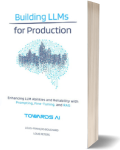Building LLMs for Production
Artificial Intelligence
Book Details
Book Title
Building LLMs for Production
Author
Louis-Francois Bouchard, Louie Peters
Publisher
Towards AI
Publication Date
2024
ISBN
9798324731472
Number of Pages
533
Language
English
Format
File Size
5.3MB
Subject
Artificial Intelligence > machine learning >large language models
Table of Contents
- What Experts Think About Building LLMs for Production
- Acknowledgement
- (Untitled)
- Preface
- (Untitled)
- Introduction
- Why Prompt Engineering, Fine-Tuning, and RAG?
- Coding Environment and Packages
- Learning Resources
- (Untitled)
- Chapter I: Introduction to LLMs
- What are Large Language Models
- Key LLM Terminologies
- From Language Models to Large Language Models
- History of NLP/LLMs
- Recap
- Chapter II: LLM Architectures and Landscape
- Understanding Transformers
- Transformer Model’s Design Choices
- The Generative Pre-trained Transformer (GPT) Architecture
- Introduction to Large Multimodal Models
- Proprietary vs. Open Models vs. Open-Source Language Models
- Applications and Use-Cases of LLMs
- Recap
- Chapter III: LLMs in Practice
- Understanding Hallucinations and Bias
- Evaluating LLM Performance
- Controlling LLM Outputs
- Pretraining and Fine-Tuning LLMs
- Recap
- Chapter IV: Introduction to Prompting
- Prompting and Prompt Engineering
- Bad Prompt Practices
- Tips for Effective Prompt Engineering
- Recap
- (Untitled)
- Chapter V: Introduction to LangChain & LlamaIndex
- LangChain Introduction
- LangChain Agents & Tools Overview
- Building LLM-Powered Applications with LangChain
- Building a News Articles Summarizer
- LlamaIndex Introduction
- LangChain vs. LlamaIndex vs. OpenAI Assistants
- Recap
- Chapter VI: Prompting with LangChain
- What are LangChain Prompt Templates
- Few-Shot Prompts and Example Selectors
- Managing Outputs with Output Parsers
- Improving Our News Articles Summarizer
- Creating Knowledge Graphs from Textual Data: Unveiling Hidden Connections
- Recap
- (Untitled)
- (Untitled)
- Chapter VII: Retrieval-Augmented Generation
- (Untitled)
- Retrieval-Augmented Generation
- LangChain’s Indexes and Retrievers
- Data Ingestion
- What are Text Splitters and Why They are Useful
- Tutorial: A Customer Support Q&A Chatbot
- Embeddings
- What are LangChain Chains
- Tutorial: A YouTube Video Summarizer Using Whisper and LangChain
- Tutorial: A Voice Assistant for Your Knowledge Base
- Preventing Undesirable Outputs With the Self-Critique Chain
- Recap
- Chapter VIII: Advanced RAG
- Prompting vs. Fine-Tuning vs. RAG
- Advanced RAG Techniques with LlamaIndex
- Production-Ready RAG Solutions with LlamaIndex
- RAG - Metrics & Evaluation
- LangChain’s LangSmith – Introduction
- Recap
- (Untitled)
- Chapter IX: Agents
- What are Agents: Large Models as Reasoning Engines
- An Overview of AutoGPT and BabyAGI
- The Agent Simulation Projects in LangChain
- Tutorial: Building Agents for Analysis Report Creation
- Tutorial: Query and Summarize a DB with LlamaIndex
- Building Agents with OpenAI Assistants
- Complement Your Agents Using Hugging Face’s APIs
- LangChain OpenGPT
- Tutorial: Multimodal Financial Document Analysis from PDFs
- Recap
- Chapter X: Fine-Tuning
- Techniques for Fine-Tuning LLMs
- Low-Rank Adaptation (LoRA)
- Practical Example: SFT with LoRA
- Using SFT for Financial Sentiment
- Fine-Tuning a Cohere LLM with Medical Data
- Reinforcement Learning from Human Feedback
- Tutorial: Improving LLMs with RLHF
- Recap
- Chapter XI: Deployment
- Challenges of LLM Deployment
- Model Quantization
- Model Pruning
- Deploying an LLM on a Cloud CPU
- Recap
- (Untitled)
- Conclusion
